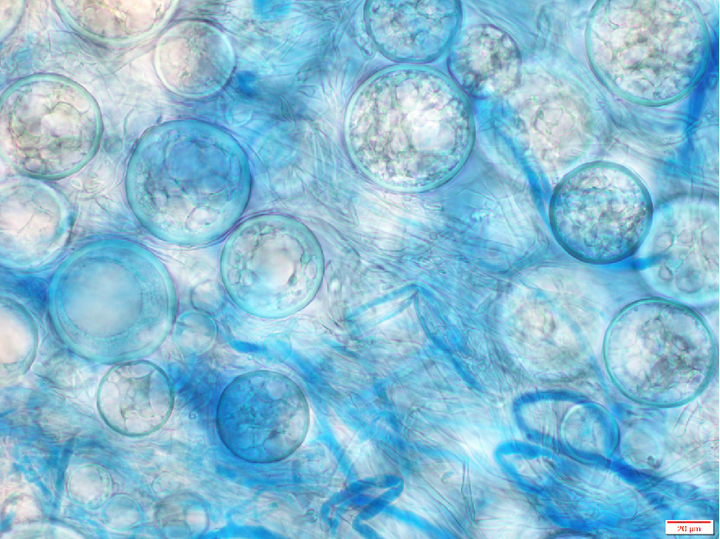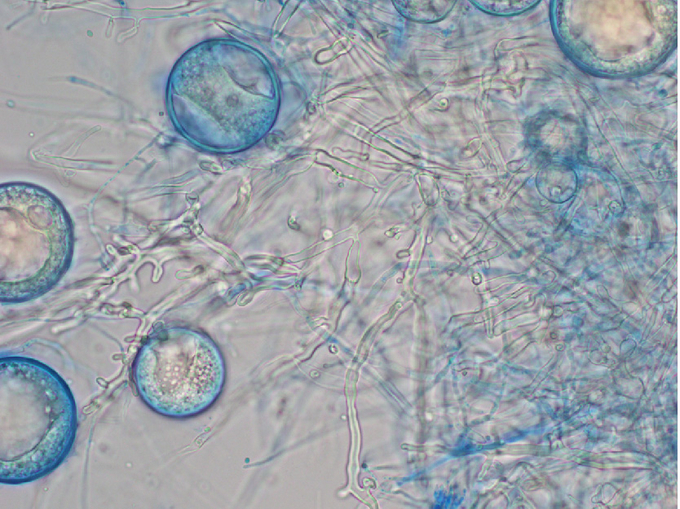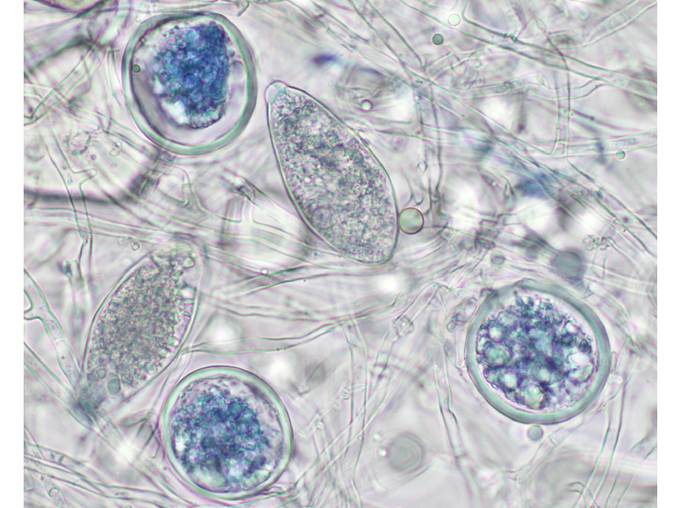Phytophthora ramorum
Phytophthora ramorum
Profile
Phytophtora ramorum is a fungal disease that affects a wide range of plants (both ornamentals and forest plants). The infestation is recognized by leaf spots, shoot death and dark discoloration of the bark. Phytophthora ramorum is listed as a Union quarantine pathogen and is one of the pathogens that do not occur in the Union. However, this applies only to the non-European isolates.
Biology

Phytophthora ramorum belongs to the oomycetes (egg fungi) and is very well adapted to life in water. With sufficient soil or leaf moisture, sporangia are rapidly formed in large numbers. These release numerous zoospores that can actively travel in water. This allows them to reach their host plants. Thick-walled chlamydospores are formed for survival. Sexual oospores have not yet been detected in nature. Phytophthora ramorum prefers moderate temperatures between 15 and 25 °C.
Damage symptoms
Phytophthora ramorum causes three different types of damage:
- Leaf spot
- Shoot dieback
- cambium necrosis with "tar spots" and slime flow
Depending on the species of woody plants, one or more of these symptom manifestations may occur. Leaf spots are the most common. These may be dark brown to blackish brown in color, as in rhododendron, or light brown to dark brown as in California horse chestnut. The spots are usually sharply defined.
When associated with shoot infections, the infection progresses across the leaf base to the leaf tip. The midrib is then heavily browned. In shoot dieback, the infected shoots usually turn dark brown to blackish brown. Depending on the species, the discoloration can start either from the shoot tip (rhododendron), from the middle of the shoot or from the base of the shoot.
Cambium necrosis is mainly found on plants of the beech family (Fagaceae, such as beech(Fagus), oak(Quercus), Lithocarpus) and on snowball(Viburnum). Externally, these necroses can often be recognized by dark discolorations of the bark, so-called "tar spots", combined with mucus flow. If the discolored bark areas are removed, the tissue is usually found to be clearly discolored red to blackish brown. Often, depending on the type of wood, numerous areas sharply demarcated from the healthy but also from the diseased tissue are visible in the form of reddish lines. At the beginning of the infection, these discolorations are usually limited to a few lenticular areas. As the disease progresses, they merge more and more. These stem necroses occur preferentially at the base of the stem and then extend up the stem. Occasionally, however, necrosis also occurs in the crown area, but no connection to the base of the trunk was observed.
Host plants
Phytophthora ramorum has an extremely wide host plant range. Preferred hosts include:
Acer macrophyllum, Acer pseudoplatanus, Adiantum aleuticum, Adiantum jordanii, Aesculus californica, Aesculus hippocastanum, Arbutus menziesii, Arbutus unedo, Arctostaphylos spp., Calluna vulgaris, Camellia spp., Castanea sativa, Fagus sylvatica, Frangula californica, Frangula purshiana, Fraxinus excelsior, Griselinia littoralis, Hamamelis virginiana, Heteromeles arbutifolia, Kalmia latifolia, Laurus nobilis, Leucothoe spp., Lithocarpus densiflorus, Lonicera hispidula, Magnolia spp., Michelia doltsopa, Nothofagus obliqua, Osmanthus heterophyllus, Parrotia persica, Photinia x fraseri, Pieris spp., Pseudotsuga menziesii, Qercus spp., Rhododendron spp. (except Rhododendron simsii), Rosa gymnocarpa, Salix caprea, Sequoia sempervirens, Syringa vulgaris, Taxus spp., Trientalis latifolia, Umbellularia californica, Vaccinium ovatum and Viburnum spp.
Distribution
Phytophthora ramurum is spread by infected plants, contaminated soil and water, and rain and mist droplets. In Europe, Phytophthora ramorum occurs primarily on ornamental plants and has also been carried with the trade in ornamental plants. This is facilitated by the fact that the pathogen can also be latent in its host plants. This means that the pathogen has infected the plant, but there are no visible symptoms.
Propagation and transmission
Wounds are ideal ports of entry for the pathogen, but the pathogen can also enter plants through natural openings such as stomata or lenticels or healthy tissue. Warm, humid weather promotes the disease. In addition to high humidity, P. ramorum prefers moderate temperatures. Winter survival is possible in the soil and in the leaf litter layer.
Phytosanitary status
Phytophthora ramorum is included in the list of Union quarantine pathogens and is one of those pathogens that do not occur in the Union territory. However, this applies only to the non-European isolates.
Specialized information
Phytophthora ramorum forms numerous mostly terminal, thick-walled chlamydospores in culture on carrot juice or carrot shred agar. They are spherical, hyaline to slightly pigmented, and their diameter is 20-91 µm (average 46-60 µm). The semi-papillary sporangia are hyaline, elliptic to elongate-ovate and short stalked. The total size of the of the sporangia 25-97 x 14-34 µm (average 54-56 x 27-28 µm). The length to width ratio ranges from 1.8 to 2.4. The mycelium is coralloid and the hyphae do not show swellings. In water, the sporangia germinate with flagellated zoospores.


Last updated: 25.05.2023
automatically translated